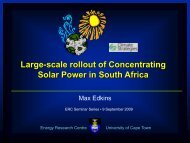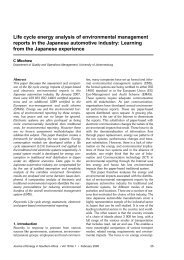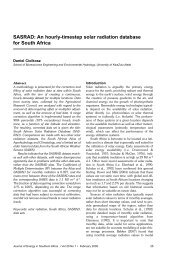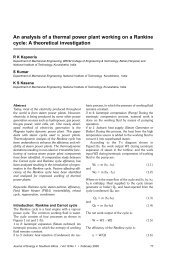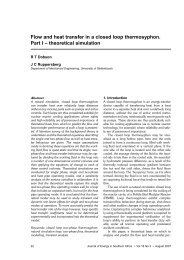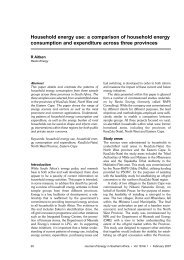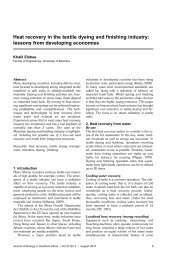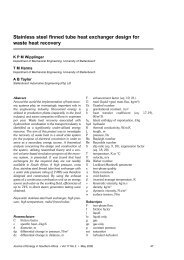Solar electrification by the concession approach in rural Limpopo ...
Solar electrification by the concession approach in rural Limpopo ...
Solar electrification by the concession approach in rural Limpopo ...
You also want an ePaper? Increase the reach of your titles
YUMPU automatically turns print PDFs into web optimized ePapers that Google loves.
<strong>Solar</strong> <strong>electrification</strong> <strong>by</strong> <strong>the</strong> <strong>concession</strong> <strong>approach</strong> <strong>in</strong> <strong>rural</strong> <strong>Limpopo</strong> prov<strong>in</strong>ce 3310.4 Enterta<strong>in</strong>mentDuration per day of TV watch<strong>in</strong>gTable 10.5: Duration per day of TV watch<strong>in</strong>gSHS-users Grid-users* Non-electrified householdsAbout 4 hours 6% 24% 2%Up to 4 hours 37% 51% 26%One hour 4% 0% 3%*The m<strong>in</strong>imum for grid-electrified households was 2 hours.Grid users were found to watch TV for at least 2 hours, and had <strong>the</strong> highest number of householdmembers watch<strong>in</strong>g for four hours and more. The constra<strong>in</strong><strong>in</strong>g effect of SHS is apparent, with only6% report<strong>in</strong>g about four hours TV watch<strong>in</strong>g.10.5 Education (extension of times of children’s homework)Persons <strong>in</strong> <strong>the</strong> household study<strong>in</strong>g or do<strong>in</strong>g homeworkTable 10.6: Persons <strong>in</strong> <strong>the</strong> household study<strong>in</strong>g or do<strong>in</strong>g homeworkSHSusersGridusersNon-electrified householdsYes 83% 71% 81%No 17% 29% 19%There were high percentages of persons study<strong>in</strong>g <strong>in</strong> all sub-samples, particularly among <strong>the</strong> SHSusersand non-electrified households. The questions of how long <strong>the</strong>y study and <strong>the</strong> extent to whichSHS-users make use of solar light<strong>in</strong>g are explored <strong>in</strong> <strong>the</strong> follow<strong>in</strong>g tables.Table 10.7: Length of time <strong>the</strong>y studySHS-users Grid-users Non-electrified householdsLess than one hour 0% 2% 2%One to two hours 29% 33% 49%Miss<strong>in</strong>g or n/a 16% 29% 21%The length of time students study does not seem to depend on <strong>the</strong> <strong>electrification</strong> sub-sample to which<strong>the</strong>y belong. Those study<strong>in</strong>g with grid light<strong>in</strong>g or solar lights do so under better light, but study isnever<strong>the</strong>less possible with candles. The SHS-users also report study<strong>in</strong>g with, and sometimes withoutus<strong>in</strong>g <strong>the</strong>ir solar lights.Table 10.8: Use of solar light when study<strong>in</strong>gSHS-usersAlways 43%Sometimes 41%Never 0%n/a 17%There were no respondents who claimed never to use <strong>the</strong>ir solar lights when study<strong>in</strong>g. 43% claimed<strong>the</strong>y always used <strong>the</strong>ir solar lights, and 41% sometimes used <strong>the</strong>ir solar lights when study<strong>in</strong>g. Thereason for <strong>the</strong> sizeable proportion of respondents who use <strong>the</strong>ir solar lights sometimes for study<strong>in</strong>gmay be due to reliability of <strong>the</strong>ir SHSs, limited hours of operation of <strong>the</strong> SHSs, or because not allENERGY RESEARCH CENTRE




